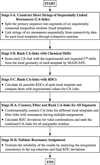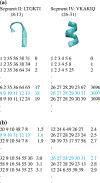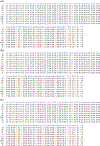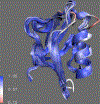RDC derived protein backbone resonance assignment using fragment assembly
- PMID: 21191805
- PMCID: PMC6936109
- DOI: 10.1007/s10858-010-9467-z
RDC derived protein backbone resonance assignment using fragment assembly
Abstract
Experimental residual dipolar couplings (RDCs) in combination with structural models have the potential for accelerating the protein backbone resonance assignment process because RDCs can be measured accurately and interpreted quantitatively. However, this application has been limited due to the need for very high-resolution structural templates. Here, we introduce a new approach to resonance assignment based on optimal agreement between the experimental and calculated RDCs from a structural template that contains all assignable residues. To overcome the inherent computational complexity of such a global search, we have adopted an efficient two-stage search algorithm and included connectivity data from conventional assignment experiments. In the first stage, a list of strings of resonances (CA-links) is generated via exhaustive searches for short segments of sequentially connected residues in a protein (local templates), and then ranked by the agreement of the experimental (13)C(α) chemical shifts and (15)N-(1)H RDCs to the predicted values for each local template. In the second stage, the top CA-links for different local templates in stage I are combinatorially connected to produce CA-links for all assignable residues. The resulting CA-links are ranked for resonance assignment according to their measured RDCs and predicted values from a tertiary structure. Since the final RDC ranking of CA-links includes all assignable residues and the assignment is derived from a "global minimum", our approach is far less reliant on the quality of experimental data and structural templates. The present approach is validated with the assignments of several proteins, including a 42 kDa maltose binding protein (MBP) using RDCs and structural templates of varying quality. Since backbone resonance assignment is an essential first step for most of biomolecular NMR applications and is often a bottleneck for large systems, we expect that this new approach will improve the efficiency of the assignment process for small and medium size proteins and will extend the size limits assignable by current methods for proteins with structural models.
Figures




Similar articles
-
Backbone assignment of proteins with known structure using residual dipolar couplings.J Biomol NMR. 2004 Sep;30(1):25-35. doi: 10.1023/B:JNMR.0000042955.14647.77. J Biomol NMR. 2004. PMID: 15452432
-
Protein side-chain resonance assignment and NOE assignment using RDC-defined backbones without TOCSY data.J Biomol NMR. 2011 Aug;50(4):371-95. doi: 10.1007/s10858-011-9522-4. Epub 2011 Jun 25. J Biomol NMR. 2011. PMID: 21706248 Free PMC article.
-
High-resolution protein structure determination starting with a global fold calculated from exact solutions to the RDC equations.J Biomol NMR. 2009 Nov;45(3):265-81. doi: 10.1007/s10858-009-9366-3. Epub 2009 Aug 27. J Biomol NMR. 2009. PMID: 19711185 Free PMC article.
-
Advances in NMR Spectroscopy of Weakly Aligned Biomolecular Systems.Chem Rev. 2022 May 25;122(10):9307-9330. doi: 10.1021/acs.chemrev.1c00730. Epub 2021 Nov 12. Chem Rev. 2022. PMID: 34766756 Review.
-
The use of residual dipolar coupling in studying proteins by NMR.Top Curr Chem. 2012;326:47-67. doi: 10.1007/128_2011_215. Top Curr Chem. 2012. PMID: 21952837 Free PMC article. Review.
Cited by
-
A complex affair: Attraction and repulsion make occludin and ZO-1 function!Tissue Barriers. 2013 Jan 1;1(1):e23496. doi: 10.4161/tisb.23496. Tissue Barriers. 2013. PMID: 24665376 Free PMC article.
-
Advances in the REDCAT software package.BMC Bioinformatics. 2013 Oct 7;14:302. doi: 10.1186/1471-2105-14-302. BMC Bioinformatics. 2013. PMID: 24098943 Free PMC article.
-
Sparse labeling of proteins: structural characterization from long range constraints.J Magn Reson. 2014 Apr;241:32-40. doi: 10.1016/j.jmr.2013.12.012. J Magn Reson. 2014. PMID: 24656078 Free PMC article. Review.
-
Rapid measurement of residual dipolar couplings for fast fold elucidation of proteins.J Biomol NMR. 2011 Nov;51(3):369-78. doi: 10.1007/s10858-011-9567-4. Epub 2011 Sep 14. J Biomol NMR. 2011. PMID: 21915680
-
Increased usability, algorithmic improvements and incorporation of data mining for structure calculation of proteins with REDCRAFT software package.BMC Bioinformatics. 2020 Dec 3;21(Suppl 9):204. doi: 10.1186/s12859-020-3522-x. BMC Bioinformatics. 2020. PMID: 33272215 Free PMC article.
References
-
- Al-Hashimi HM, Valafar H, Terrell M, Zartler ER, Eidsness MK, Prestegard JH (2000) Variation of molecular alignment as a means of resolving orientational ambiguities in protein structures from dipolar couplings. J Magn Reson 143:402–406 - PubMed
-
- Andrec M, Du PC, Levy RM (2001) Protein backbone structure determination using only residual dipolar couplings from one ordering medium. J Biomol NMR 21:335–347 - PubMed
-
- Apaydin MS, Conitzer V, Donald BR (2008) Structure-based protein NMR assignments using native structural ensembles. J Biomol NMR 40:263–276 - PubMed
-
- Baker D, Sali A (2001) Protein structure prediction and structural genomics. Science 294:93–96 - PubMed
Publication types
MeSH terms
Substances
Grants and funding
LinkOut - more resources
Full Text Sources
Miscellaneous

